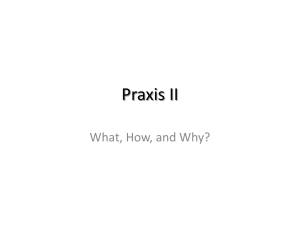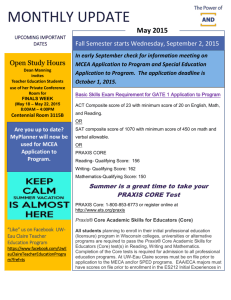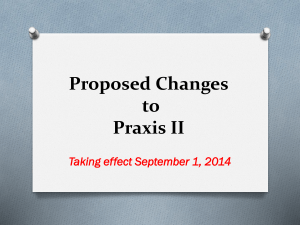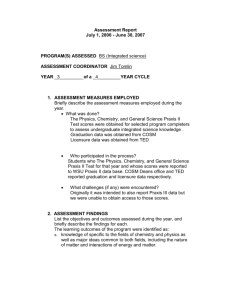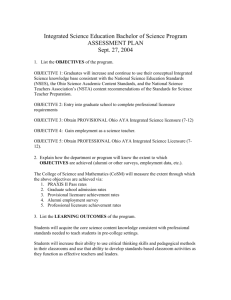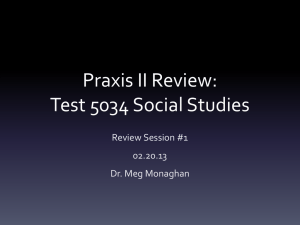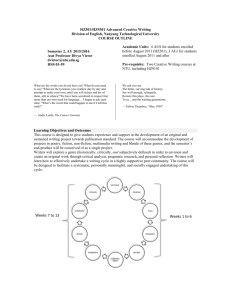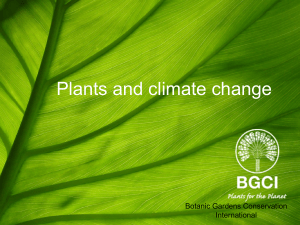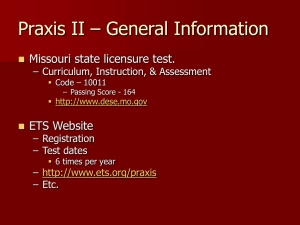IECE Praxis II: Play and Learning Environment
advertisement
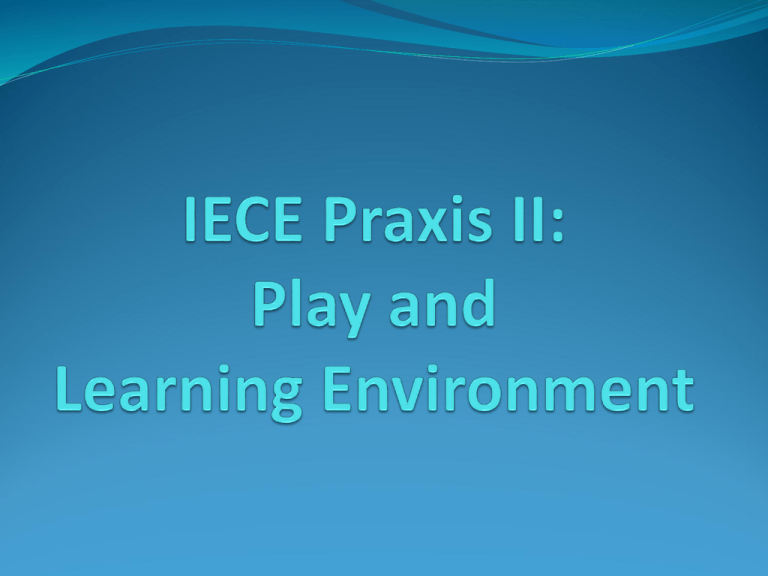
Praxis Practice Question 1 Ms. Graham, a kindergarten teacher, sets up floor materials in two areas of the classroom each morning, so the children can interact in groups as they come in. Typically, the materials include a puzzle with several pieces and board games. Which of the following types of interaction is the teacher facilitating? (A) Associative Play (B) Cooperative Play (C) Parallel Play (D) Functional Play Play Jean Piaget says A child’s work is play. Children learn though play. Adults set up the environment to encourage different types of play. From the teachers standpoint it should be Play with a Purpose. Vygotskian approach to Play Play affects the child’s motivation. Play facilitates cognitive decentering. Play advances the development of mental representations. Play fosters the development of deliberate behaviors – physical and mental voluntary actions. According to Vygotskians, only when these four outcomes are in place can a young child profit fully from academic activities. Praxis Practice Question 2 Which of the following is an example of an assistive technology that can be used with a child who has a communication delay? (A) Battery operated riding toys and power scooters (B) Plastic, cloth, or fiberglass braces (C) Non-electronic board or notebook (D) Toys with large handles, switches, and controls Characteristics of Play Teacher involvement decreases over time as experience helps children gain independence in negotiating. The process is the activity; it keeps children involved, exploring and discovering without a defined beginning or end. The play-versus-reality distinction inherent in fantasy or pretend is called nonliterality. This is where children escape reality, forgo limits, and have power over what they do. Types of Play Nonsocial Activity or Solitary Play Unoccupied, onlooker behavior Parallel Play Plays near other children with similar toys, but does not try to influence them Associative Play Engage in separate activities, but exchange toys and comments Cooperative Play Children work toward a common goal (such as make-believe play). Cognitive Play Categories Functional Play Simple, repetitive 0–2 years motor movements, with or without objects Constructive Play Creating or 3–6 years constructing something Make-Believe Play Acting out everyday and imaginative roles 2–6 years Praxis Practice Question 3 A caregiver is setting up an activity center to support the fine motor skills development of 3 – to 4 – year old children. Which of the following is an appropriate activity to support this goal? (A) Sweeping with a broom and using a dust pan (B) Removing and replacing lids and caps of containers (C) Throwing a basketball into the net (D) Dancing to simple tunes and music patterns The Learning Environment The arrangement of the learning environment is as important to the classroom as the instructional time. The learning environment acts as an extra teacher in the classroom. A healthy environment supports children’s physical and mental health. A respectful environment is one in which teachers deeply care about the children and families. A supportive environment is one where the teacher spends time with the children, pleasantly interacts with them and encourages and help them. Learning Environment needs to be Clean Well maintained Loving Balance of small and large open space Have a variety of well defined learning centers Well arranged Safe Have a good traffic flow Praxis Practice Question 4 Which of the following is the best example of a developmentally appropriate environment for a group of 3year-old children? (A) The choice of materials by the caregiver is related to the caregiver’s interests, and is restrictive in use. (B) The daily activities are completed in groups, and the caregiver has an opportunity to introduce several activities each day. (C) The caregiver’s plan provides time for individual and group activities, and the children have time for experimentation. (D) Outside activities is limited to once in two weeks, since the children have lots of indoor materials to work with. Learning Environment – A context for teaching and learning 1/3 how the environment is arranged physical environment 1/3 what teacher does in the environment Cognitive/academic 1/3 the other children in the environment Social/emotional environment Context for Teaching & Learning Scheduling 2. Selecting Activities 3. Designing Learning Centers & Selecting Materials 4. Planning and structuring activities to ensure that all children can participate 1. Praxis Practice Question 5 Which of the following materials would be most appropriate for teaching 4-year-old children about patterns? (A) Cards showing simple patterns in bright colors (B) Manipulatives that can be arranged in patterns (C) Books that define and feature illustrations of patterns (D) Worksheets containing pattern-identification activities Context: Schedule Fosters Engagement Function with Independence Anticipate Transitions Prevent Challenging Behavior Balance of activities (active/passive; teacherdirected/child-selected; large/small group/ centers/individual) 2. Length of time – changes during the year 3. Novelty embedded into Consistency 4. Transitions – Reduce; Anticipate; Learning Opportunities; Teach Expectations 1. Context: Selecting Activities Throughout day – across activities & environments Child-directed; Teacher-directed; Routines All provide opportunities to teach content and dispositions (persistence, independence,…) Embedded Learning Opportunities Interesting Opportunities to practice and use peer modeling Routines – maximize target behaviors including adaptive skills & caring for environment Praxis Practice Question 6 A class, made up of children with diverse needs and abilities, is grouped for an activity. In the groups, the children will assist each other according to their individual strengths and abilities. Such a grouping strategy is an example of which of the following? (A) Homogenous clustering (B) Cooperative learning (C) Scaffolding (D) Tiered instruction Adaptation Continuum Adapt Environment Adapt Activity or Routine Adapt Materials Adapt Instruction Provide Assistance Least to Most Intrusive The Goal: Use the least intrusive adaptation. If an adaptation is not having the result you want, try the next least intrusive adaptation. Praxis Practice Question 7 Which of the following will best support the development of literacy skills of an English language learner (ELL) in an early childhood setting? (A) Allowing bilingual children to speak and learn to write in their preferred language (B) Grouping all bilingual children together during classroom activities (C) Including in the reading area only books written in the English language (D) Requiring bilingual children to verbally express themselves in English only Adapt Environment – changes to the setting Adapt room set-up ◦ Rearrange the furniture so child in wheelchair can move freely ◦ Invisible support: arrange materials sequentially Adapt/select equipment ◦ Ex: use a slant board to help child participate in coloring activities or a wedge to provide supportive seating during circle activities Adaptations to Activities and Routines Continuum: Select to meet child’s ability Select to support child’s preferences Adapt activity or routine to accommodate a special need Add periodic movement activities to a story time activity to help children who have difficulty paying attention. Extend the length of free choice time so that children have the opportunity to finish a block building project. Praxis Practice Question 8 The parents of a 5-month-old infant are searching for a suitable child care center for their baby. Which of the following best characterizes an environment that functions within professional guidelines? (A) The ratio of adults to infants is one-to-eight (B) Caregivers are moved weekly from one group to another to get to know all infants in the center (C) Caregivers work with the infants in large groups, thus fostering social interaction (D) The ratio of adults to infants is limited to allow for one-to-one interaction Adaptations to Materials Continuum: Make the pencil thicker by putting a foam curler around it or by wrapping the pencil with play dough or silly putty to help a child who has problems gripping pencils. Use assistive technology— a simple switch interface to help a child with motor difficulties activate a toy. Visual cues – photos to remind child of handwashing steps Continuum: Requirements and Instruction Changing the requirements of an activity or a routine, or the way you provide instruction for them, can enable a child to participate. For example: Modality reinforcement: Use photographs to show each step rather than simply speaking the instructions. Simplification: Reduce the number of steps a child is expected to perform to change requirements; task analysis Praxis Practice Question 9 Which of the following activities is most appropriate for a teacher to use to introduce a group of 4-year-old children to the concepts of life cycles using butterflies? (A) The teacher talks to the children for 30 minutes on how butterflies develop (B) The teacher reads a book about butterflies to the children (C) The teacher asks the children to color a picture of different types of butterflies (D) The teacher brings a butterfly habitat with eggs and larvae to the class Continuum: Assistance Providing assistance is the most intrusive form of adaptation because it involves another child (peer assistance) or adult actually helping the child do the activity or routine, rather than allowing the child to do it independently. Always try to have a peer provide the assistance first before using an adult. Provide assistance only when other adaptations have not worked, and only as a last resort. Activity Divide up into 6 groups (Dramatic Play, Blocks or Construction, Puzzles or Manipulative, Science or Nature, Books or Library, Art) Select a learning center poster On the poster list The items you would need for that learning center Activities that could be used in that learning center Where in the classroom would be the best place for the center. Praxis Practice Question 10 Which of the following materials will provide the most opportunity for children to play, learn and explore? (A) A bowl with very large beads in different sizes and colors (B) A bird that sings and flaps its wings when the power button is turned on (C) A battery operated car that can hoot when it bumps into any object (D) A box with the letters of the alphabet written around it Wrap-up Give prize to the person who has the most answers correct Remind participants to pick up a sticker as they leave Give out evaluations Close in prayer References Berk, L. (2008). Infants and Children Prenatal through Middle Childhood Sixth Edition. New York, NY: Pearson Brown, J., Hemmeter, M, & Pretti-Frontczak. (2005) Blended Practices for Teaching Young Children in Inclusive Settings. Baltimore, MD: Brooks Publishing. Koralek, D. (2004) Spotlight on Young Children and Play. Young Children. National Association of the Education of Young Children. Morrison, G. (2011) Fundamentals of Early Childhood Education. Sixth Edition. New York, NY: Pearson.
